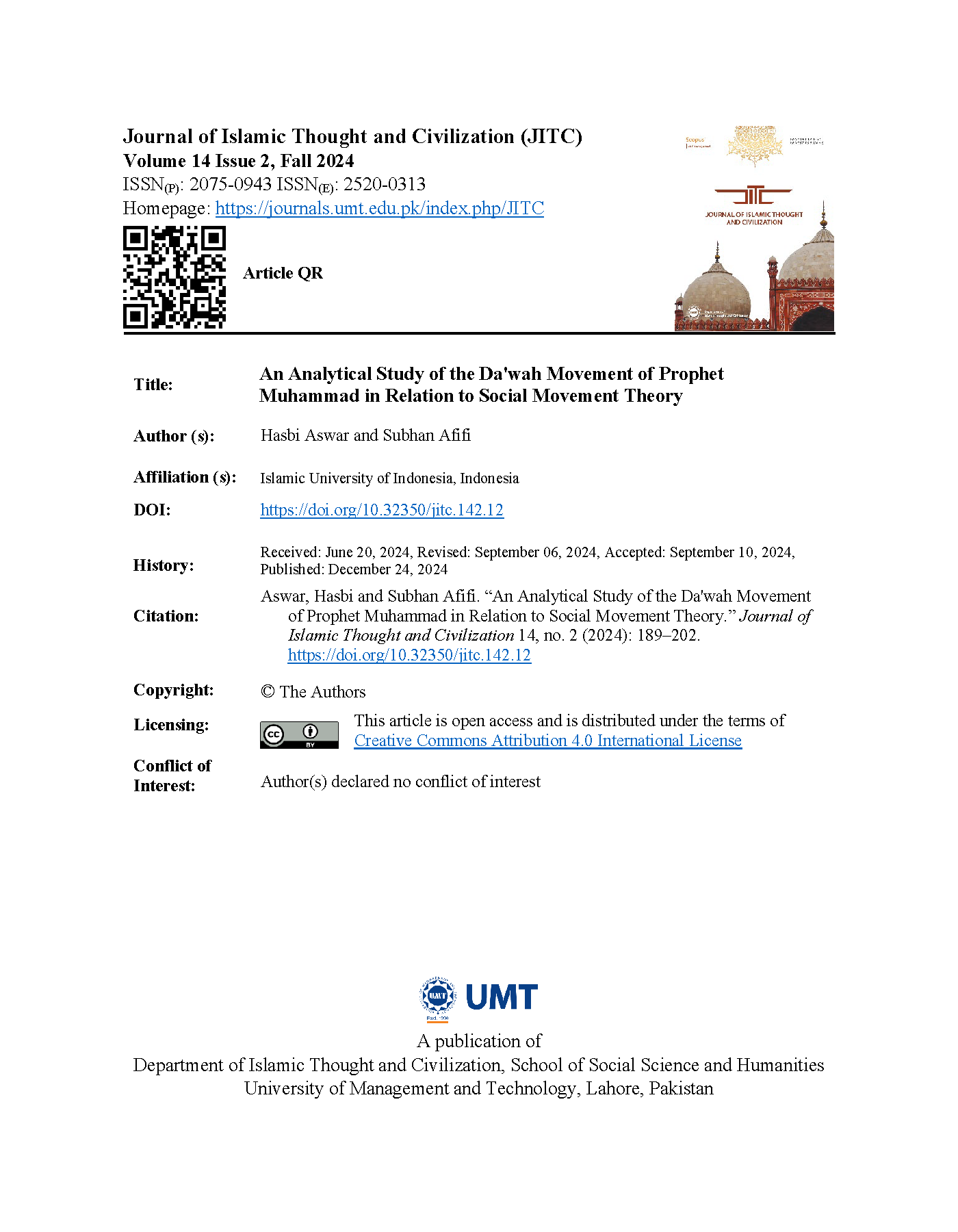An Analytical Study of the Da'wah Movement of Prophet Muhammad in Relation to Social Movement Theory
Abstract
 Abstract Views: 0
Abstract Views: 0
This article explores the da’wah activities of Prophet Muhammad through the perspective of social movements to provide new insights. This article explains that the Prophet Muhammad was not only a religious activist who worked to spread Islam but also a statesman who successfully led his followers to establish a new state in Yathrib (Medina). This research focuses on the Prophet's endeavours in political activism through the movement aimed at achieving social and political change. This study will analyse the da’wah movement using social movement perspectives, focusing on structural-functional theory, resource mobilization theory, political opportunity structure, and framing theory. This article argues that the success of the Prophet's da’wah and political initiatives is rooted in the structural conditions of Mecca and the mobilization strategies. The strength of religious narratives and the capacity to exploit narrow political opportunities while generating the new ones have played a vital role to support da’wah activities. This research uses a historical qualitative methodology, leveraging primary and secondary sources to analyse the socio-political landscape of Mecca, the Prophet's resource mobilization techniques, and the framing of his religious messages. This article is an initial investigation into the integration of social movement theories within the context of Islamic social movements, highlighting the importance of overcoming Western secular dominance of social movement studies.
Downloads
References
Afzaal, Ahmed. ‘The Origin of Islam as a Social Movement’. Islamic Studies 42, no. 2 (2003): 203–43.
Alkhateeb, Firas. Sejarah Islam Yang Hilang: Menelusuri Kembali Kejayaan Muslim Pada Masa Lalu (Lost Islamic History: Reclaiming Muslim Civilisation from the Past). Sleman: Penerbit Bentang, 2014.
Al-Usairy., Ahmad. Sejarah Islam Sejak Nabi Adam Hingga Abad XX (Islamic History From Prophet Adam to the XX Century). Jakarta: Akbar Media Eka Sarana, 2004.
An-Nabahani, Taqiuddin. The Islamic State. London: Al-Khilafah Publications, 1998.
Armstrong, Karen. Islam: A Short History. New York: Modern Library, 2002.
———. Muhammad: Prophet for Our Time. Bandung: Mizan, 2007.
———. Sejarah Tuhan: Kisah Pencarian Tuhan Yang Dilakukan Oleh Orang-Orang Yahudi, Kristen, Dan Islam Selama 4.000 Tahun (God's History: The Story of God's Quest for God by Jews, Christians, and Muslims for 4,000 Years). Bandung.: Penerbit Mizan, 2002.
Benford, Robert D, and David A Snow. ‘Framing Processes and Social Movements: An Overview and Assessment’. Annual Review of Sociology, 2000. https://doi.org/10.1146/annurev.soc.26.1.611.
Bin Masood, Farid. ‘A Sociological Analysis of Islamic Revolutionary Movement of 7th Century CE’. Alınteri Sosyal Bilimler Dergisi 2, no. 3 (26 July 2018): 77–96. https://doi.org/10.30913/alinterisosbil.368258.
Bloom, Jack M. ‘Political Opportunity Structure, Contentious Social Movements, and State-Based Organizations: The Fight against Solidarity inside the Polish United Workers Party’. Social Science History 38, no. 3–4 (2015): 359–88. https://doi.org/10.1017/ssh.2015.29.
Edwards, Bob, and Patrick F. Gillham. ‘Resource Mobilization Theory’. In The Wiley-Blackwell Encyclopedia of Social and Political Movements, edited by Donatella Della Porta, Bert Klandermans, Doug McAdam, and David A. Snow, 1st ed. Wiley, 2013. https://doi.org/10.1002/9780470674871.wbespm447.
Karagiannis, Emmanuel. ‘Political Islam and Social Movement Theory: The Case of Hizb Ut-Tahrir in Kyrgyzstan’. Religion, State and Society 33, no. 2 (2005): 137–50. https://doi.org/10.1080/09637490500118638.
Khalid, Khalid Muhammad. Muhammad SAW Sang Rasul Terkasih (Muhammad PBUH the Beloved Apostle),. Bandung: Penerbit Mizania, 2014.
Khattab, Dr. Mustafa, trans. ‘Surah Al-Anbya, 21: 98’. Quran.com. Accessed 31 July 2024. https://quran.com/al-anbya.
———. ‘Surah Al-’Ankabut, 29: 63’. Quran.com. Accessed 31 July 2024. https://quran.com/al-ankabut.
———. ‘Surah An-Najm, 53: 19-26’. Quran.com. Accessed 31 July 2024. https://quran.com/an-najm.
———. ‘Surah Az-Zukhruf, 43:87’. Quran.com. Accessed 31 July 2024. https://quran.com/az-zukhruf/87.
———. ‘Surah Saba, 34: 28’. Quran.com. Accessed 3 September 2024. https://quran.com/saba/28.
McAdam, Doug. ‘Conceptual Origins, Current Problems, Future Directions’. In Comparative Perspectives on Social Movements: Political Opportunities, Mobilizing Structures, and Cultural Framings, edited by Doug McAdam, John D McCarthy, and Mayer N Zald, 23–40. Cambridge University Press, 1996.
Qol’ahji, Muh. Rawwas. Buku Sirah Nabawiyah Sisi Politis: Perjuangan Dakwah Rasulullah SAW ((The Political Side of the Nabawiyah Sirah Book: The Struggle of the Prophet Muhammad SAW's Da'wah). Bogor: Al Azhar Press, 2020.
Uchrowi, Zaim. Muhammad Sang Teladan Riwayat Hidup Rasulullah Dalam Perspektif Abad 21. (Muhammad the Exemplar of the Prophet's Life History in the Perspective of the 21st Century). Jakarta Timur: PT Balai Pustaka, 2011.
Watt, W. Montgomery. Muhammad: Prophet and Statesmen. Oxford: Oxford University Press, 1961.
———. Prophet and Statement Muhammad. Yogyakarta: Diva Press, 2020.
Yasin T. Al-Jibouri. ‘Khadijah, Daughter of Khuwaylid, Wife of Prophet Muhammad | Al-Islam.Org’. Accessed 13 November 2022. https://www.al-islam.org/articles/khadijah-daughter-khuwaylid-wife-prophet-muhammad-yasin-t-al-jibouri.

Copyright (c) 2024 Hasbi Aswar, Subhan Afifi

This work is licensed under a Creative Commons Attribution 4.0 International License.

This work is licensed under a Creative Commons Attribution 4.0 International License. Authors retain copyright and grant the journal right of first publication with the work simultaneously licensed under a Creative Commons Attribution (CC-BY) 4.0 License that allows others to share the work with an acknowledgement of the work’s authorship and initial publication in this journal.







